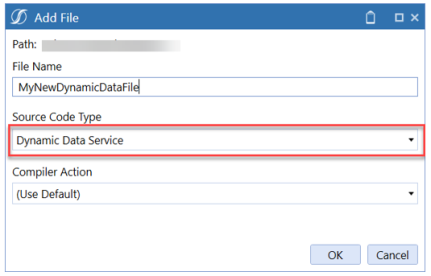Workspace Assembly files are designed to emulate the content of data record tables. The core definition must construct a list of data records that contain the required content of a data unit. This allows the Finance engine to properly interpret the data. The resulting data, which can be numeric or text-based, is in memory cached dynamic data.
A data unit consists of the following objects:
-
Entitiy
-
Parent
-
Scenario
-
Consolidation
-
Time
A dynamic data service enables a dynamic cube to read and write data from an internal or external source.

The main elements of the file are:
-
ReadDynamicDataUnitContentTimeStamp: Assign a time stamp to trigger the refresh of data unit. Refer to Workspace Assembly Dynamic Dimensions.htm.
-
ReadDynamicDataUnitData: An object developed through supporting methods and designed to retrieve data from sources, such as an external database. This populates the dynamic cube.
-
SaveDynamicDataCells: An object consisting of a dynamic cube cells designed to write-back to a target, such as an external table.
Workspace assembly initialization of the DynamicDataUnitData object includes properties to evaluate the last time of refresh using Date-Time, and the refresh cadence using the numSecondsBeforeReadingContentTimeStamp.
Refresh triggering options occur upon a change to the workspace assembly file. This occurs daily, hourly, and by the minute. Refer to the following example.

Designers must define the retrieval of data from the source system as a DataBufferCellPk object. This object is supplied to functions designed to simplify emulating data record tables. These functions support setting a records CellStatus Storage-Type and Is-Real-Data properties. Source record metadata must be aligned with the dynamic cube dimension Member ID. Transformations must be defined in the workspace assembly file.

Note the following definitions:
-
SetDataCell: Sets numeric values to a defined time at the V#YTD or V#Periodic members.
-
SetDataCellAnnotation: Sets text values to a defined time at the V#Annotation member.
-
SetDataCellUsingCellIndex: Sets numeric values to a zero-based time index supporting full data unit emulation at the V#YTD or V#Periodic members.
-
SetDataCellAnnotationUsingCellIndex: Sets text values to a zero-based time index supporting full data unit emulation at the V#Annotation member.

The workspace assembly file should define all the base-level dimension intersections that are valid in the dynamic cube. The resulting object is dynamic data. Data will populate all the undefined members available to the data buffer. Data buffer members can be fixed to a base level member if they are not definable in the source system, such as the origin dimension targeting Import, AdjInput or Forms. Without reference, the consolidation dimension will be populated at local and translated. Local and specified currencies can be targeted.



